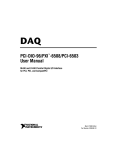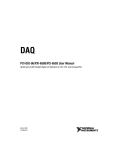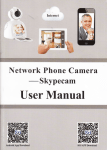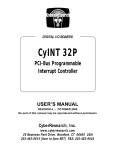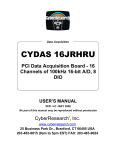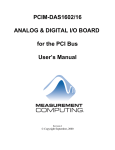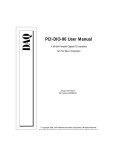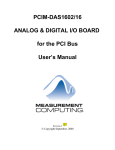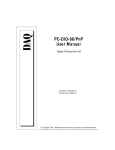Download CyberResearch CYDIO 96P User`s manual
Transcript
® Digital I/O CYDIO 96P Multi-Channel Digital I/O Board 96-Channel, TTL-Level PCI Board with 100-Pin Connection USER’S MANUAL VER. 2 • NOV 2000 & No part of this manual may be reproduced without permission. CyberResearch®, Inc. www.cyberresearch.com 25 Business Park Dr., Branford, CT 06405 USA 203-483-8815 (9am to 5pm EST) FAX: 203-483-9024 ©Copyright 2003 All Rights Reserved. November 2000 The information in this document is subject to change without prior notice in order to improve reliability, design, and function and does not represent a commitment on the part of CyberResearch, Inc. In no event will CyberResearch, Inc. be liable for direct, indirect, special, incidental, or consequential damages arising out of the use of or inability to use the product or documentation, even if advised of the possibility of such damages. This document contains proprietary information protected by copyright. All rights are reserved. No part of this manual may be reproduced by any mechanical, electronic, or other means in any form without prior written permission of CyberResearch, Inc. TRADEMARKS “CyberResearch,” and “CYDIO 96P,” are trademarks of CyberResearch, Inc. Other product names mentioned herein are used for identification purposes only and may be trademarks and/or registered trademarks of their respective companies. • NOTICE • CyberResearch, Inc. does not authorize any CyberResearch product for use in life support systems, medical equipment, and/or medical devices without the written approval of the President of CyberResearch, Inc. Life support devices and systems are devices or systems which are intended for surgical implantation into the body, or to support or sustain life and whose failure to perform can be reasonably expected to result in injury. Other medical equipment includes devices used for monitoring, data acquisition, modification, or notification purposes in relation to life support, life sustaining, or vital statistic recording. CyberResearch products are not designed with the components required, are not subject to the testing required, and are not submitted to the certification required to ensure a level of reliability appropriate for the treatment and diagnosis of humans. TABLE OF CONTENTS 1 INTRODUCTION . . . . . . . . . . . . . . . . . . . . . . . . . . . . . . . . . . . . . . . . . . . . . . 1 2 INSTALLATION . . . . . . . . . . . . . . . . . . . . . . . . . . . . . . . . . . . . . . . . . . . . . . . 2 3 I/O CONNECTIONS . . . . . . . . . . . . . . . . . . . . . . . . . . . . . . . . . . . . . . . . . . . 3 3.1 CABLES AND SCREW TERMINAL BOARDS . . . . . . . . . . . . . 3 3.2 CONNECTOR DIAGRAM . . . . . . . . . . . . . . . . . . . . . . . . . . . . . . . . . . 4 3.3 SIGNAL CONNECTION CONSIDERATIONS . . . . . . . . . . . . . . 5 3.4 CYERB 24 & CYSSR 24 CONNECTIONS . . . . . . . . . . . . . . 8 4 SOFTWARE . . . . . . . . . . . . . . . . . . . . . . . . . . . . . . . . . . . . . . . . . . . . . . . . . . . . 9 4.1 UNIVERSAL LIBRARY . . . . . . . . . . . . . . . . . . . . . . . . . . . . . . . . . . . . 9 4.2 PACKAGED APPLICATION PROGRAMS . . . . . . . . . . . . . . . . . 9 5 REGISTER MAPS . . . . . . . . . . . . . . . . . . . . . . . . . . . . . . . . . . . . . . . . . . . . . 10 5.1 BADR0 . . . . . . . . . . . . . . . . . . . . . . . . . . . . . . . . . . . . . . . . . . . . . . . . . . . . 10 5.2 BADR1 . . . . . . . . . . . . . . . . . . . . . . . . . . . . . . . . . . . . . . . . . . . . . . . . . . . . 10 5.2.1 INTCSR Configure . . . . . . . . . . . . . . . . . . . . . . . . . . . . . . . . . . . . 10 5.3 BADR2 . . . . . . . . . . . . . . . . . . . . . . . . . . . . . . . . . . . . . . . . . . . . . . . . . . . . 11 5.4 BADR3 . . . . . . . . . . . . . . . . . . . . . . . . . . . . . . . . . . . . . . . . . . . . . . . . . . . . 12 5.4.1 Group 0 8255 Configuration & Data . . . . . . . . . . . . . . . . . . . 12 5.4.2 Group 1 8255 Configuration & Data . . . . . . . . . . . . . . . . . . . 14 5.4.3 Group 2 8255 Configuration & Data . . . . . . . . . . . . . . . . . . . 15 5.4.4 Group 3 8255 Configuration & Data . . . . . . . . . . . . . . . . . . . 15 5.4.5 8254 Configuration & Data . . . . . . . . . . . . . . . . . . . . . . . . . . . . 16 5.4.6 8255 Interrupt Source Configure . . . . . . . . . . . . . . . . . . . . . . . 17 5.4.7 Counter Interrupt Source Configure . . . . . . . . . . . . . . . . . . . . 18 6 SPECIFICATIONS . . . . . . . . . . . . . . . . . . . . . . . . . . . . . . . . . . . . . . . . . . . . 19 7 ELECTRONICS AND INTERFACING . . . . . . . . . . . . . . . . . . . . . . . 21 7.1 PULL UP & PULL DOWN RESISTORS . . . . . . . . . . . . . . . . . . . 21 7.2 TTL TO SOLID STATE RELAYS . . . . . . . . . . . . . . . . . . . . . . . . . . 22 7.3 VOLTAGE DIVIDERS . . . . . . . . . . . . . . . . . . . . . . . . . . . . . . . . . . . . . 23 This page is blank. 1 INTRODUCTION The CyDIO 96P is a 96-bit line digital I/O board. The board provides the 96 bits in four 24-bit groups. Each group provides an 8-bit port A and port B, as well as an 8-bit port C that can be split into independent 4-bit port C-HI and a 4-bit port C-LO. See Figure 1-1 below. On power up and reset, all I/O bits are set to input mode. If you are using the board to control items that must be OFF on reset, you will need to install pull-down resistors. Provisions have been made on the board to allow users to quickly and easily install SIP resistor networks in either pull-up or pull-down configurations. Port A (7:0) Port B (7:0) Port C Control DIO Group 3 (7:0) 82C55 CyDIO 96P Block Diagram (7:0) Port A (7:0) Port B (7:0) Port C Control DIO Group 2 82C55 CONTROLLER FPGA and LOGIC (7:0) Port A (7:0) Port B (7:0) Port C Control DIO Group 1 CONTROL BUS COUNTERS 82C54 82C55 Control Registers Decode/Status DIO Group 0 Port A (7:0) Port B (7:0) Port C 82C55 INT. Control (7:0) LOCAL BUS Boot EEPROM PCI CONTROLLER BADR3 PLX-9052 PCI BUS (5V, 32-BIT, 33MHZ) Figure 1-1. CyDIO 96P Block Diagram 1 This page is blank. 2 INSTALLATION The CyDIO 96P boards are completely plug-and-play. There are no switches or jumpers on the board. All board addresses are set by your computer’s plug-and-play software. InstaCal is the installation, calibration and test software supplied with your data acquisition / IO hardware. Refer to the Extended Software Installation Manual to install InstaCal. If you need it, there is some on-line help in the InstaCal program. Owners of the Universal Library should read the manual and examine the example programs prior to attempting any programming tasks. 2 This page is blank. 3 I/O Connections 3.1 CABLES AND SCREW TERMINAL BOARDS The board has a 100-pin, high-density Robinson-Nugent male connector (Figure 3-1). A CBL 100xx cable is used to split the 100 I/O lines into two, 50-wire cables. One connector has pins 1 to 50, the other has 51 to 100. The two I/O connectors can be connected directly to two screw-terminal boards such as the CYSTP 50E, STA 100, STA 50H or CYSTP 502E. See Figures 3-2 and 3-3 for configuration and pin out. 3 3.2 CONNECTOR DIAGRAM The CyDIO 96P I/O connector is a 100-pin type connector accessible from the rear of the PC at the expansion backplate See Figure 3-1 below for the board pin out. Port A7 B Port A6 B Port A5 B Port A4 B Port A3 B Port A2 B Port A1 B Port A0 B Port B7 B Port B6 B Port B5 B Port B4 B Port B3 B DIO Group 1 Port B2 B Port B1 B Port B0 B Port C7 B Port C6 B Port C5 B Port C4 B Port C3 B Port C2 B Port C1 B Port C0 B Port A7 A Port A6 A Port A5 A Port A4 A Port A3 A Port A2 A Port A1 A Port A0 A Port B7 A Port B6 A Port B5 A DIO Group 0 Port B4 A Port B3 A Port B2 A Port B1 A Port B0 A Port C7 A Port C6 A Port C5 A Port C4 A Port C3 A Port C2 A Port C1 A Port C0 A +5V GND 51 52 53 54 55 56 57 58 59 60 61 62 63 64 65 66 67 68 69 70 71 72 73 74 75 76 77 78 79 80 81 82 83 84 85 86 87 88 89 90 91 92 93 94 95 96 97 98 99 100 1 2 3 4 5 6 7 8 9 10 11 12 13 14 15 16 17 18 19 20 21 22 23 24 25 26 27 28 29 30 31 32 33 34 35 36 37 38 39 40 41 42 43 44 45 46 47 48 49 50 Port A7 D Port A6 D Port A5 D Port A4 D Port A3 D Port A2 D Port A1 D Port A0 D Port B7 D Port B6 D Port B5 D Port B4 D Port B3 D Port B2 D Port B1 D Port B0 D Port C7 D Port C6 D Port C5 D Port C4 D Port C3 D Port C2 D Port C1 D Port C0 D Port A7 C Port A6 C Port A5 C Port A4 C Port A3 C Port A2 C Port A1 C Port A0 C Port B7 C Port B6 C Port B5 C Port B4 C Port B3 C Port B2 C Port B1 C Port B0 C Port C7 C Port C6 C Port C5 C Port C4 C Port C3 C Port C2 C Port C1 C Port C0 C +5V GND DIO Group 3 DIO Group 2 Figure 3-1. CyDIO 96P 100-Pin Connector Pin Out 4 BOARD’S 100-PIN I/O CONNECTOR CBL 100xx CABLE I/O PINS 1 TO 50 SIGNAL CONDITIONING or 50-PIN SCREW TERMINAL BOARD. I/O PINS 51 TO 100 SIGNAL CONDITIONING OR 50-PIN SCREW TERMINAL BOARD Figure 3-2. Cable CBL 100xx Configuration 5 DIO Group 3 DIO Group 2 Port A6 D Port A4 D Port A2 D Port A0 D Port B6 D Port B4 D Port B2 D Port B0 D Port C6 D Port C4 D Port C2 D Port C0 D Port A6 C Port A4 C Port A2 C Port A0 C Port B6 C Port B4 C Port B2 C Port B0 C Port C6 C Port C4 C Port C2 C Port C0 C Ground 2 4 6 8 10 12 14 16 18 20 22 24 26 28 30 32 34 36 38 40 42 44 46 48 50 1 3 5 7 9 11 13 15 17 19 21 23 25 27 29 31 33 35 37 39 41 43 45 47 49 Port A7 D Port A5 D Port A3 D Port A1 D Port B7 D Port B5 D Port B3 D Port B1 D Port C7 D Port C5 D Port C3 D Port C1 D Port A7 C Port A5 C Port A3 C Port A1 C Port B7 C Port B5 C Port B3 C Port B1 C Port C7 C Port C5 C Port C3 C Port C1 C +5V DIO Group 3 DIO Group 2 2nd of 2 CBL 100xx 50-Pin Connectors From board pins 51 to 100 (1st connector is pin 1 to 1, etc., DIO Groups 0 and 1) 51 52 53 54 55 56 57 58 59 60 61 62 63 64 65 66 67 68 69 70 71 72 73 74 75 76 77 78 79 80 81 82 83 84 85 86 87 88 89 90 91 92 93 94 95 96 97 98 99 100 Port A7 D Port A6 D Port A5 D Port A4 D Port A3 D Port A2 D Port A1 D Port A0 D Port B7 D Port B6 D Port B5 D Port B4 D Port B3 D Port B2 D Port B1 D Port B0 D Port C7 D Port C6 D Port C5 D Port C4 D Port C3 D Port C2 D Port C1 D Port C0 D Port A7 C Port A6 C Port A5 C Port A4 C Port A3 C Port A2 C Port A1 C Port A0 C Port B7 C Port B6 C Port B5 C Port B4 C Port B3 C Port B2 C Port B1 C Port B0 C Port C7 C Port C6 C Port C5 C Port C4 C Port C3 C Port C2 C Port C1 C Port C0 C +5V GND Pins 51- 100 of 100-Pin Conn. Figure 3-3. Pin Translation - Pins 51 to 100 DI/O Signals 6 3.3 SIGNAL CONNECTION CONSIDERATIONS All the digital inputs on the CyDIO 96P are 8255 CMOS TTL. The CyDIO 96P output signals are 8255 CMOS. CyberResearch, Inc. offers a wide variety of digital signal conditioning products that provide an ideal interface between high voltage and/or high current signals and the CyDIO 96P. If you need control or monitor non-TTL level signals with your board, please refer to our catalog or our web site for the following products: CYERB series, electromechanical relay output boards CYERB "S" series, 10A electromechanical relay output boards CYSSR series solid state relay I/O module racks A description of digital interfacing is in the Interface Electronics section. IMPORTANT NOTE The 82C55 digital I/O chip initializes all ports as inputs on powerup and reset. A TTL input is a high impedance input. If you connect another TTL input device to the 82C55 it could be turned ON or OFF every time the 82C55 is reset. Remember, the 82C55 is reset to the INPUT mode. There are positions for pull-up and pull-down resistor packs on your CyDIO 96P board. To implement these, please refer to section 7.1. 7 3.4 CYERB 24 & CYSSR 24 CONNECTIONS CyDIO 96P boards provide digital I/O in two major groups of 48 bits each (96 total, but each side of the CBL 100xx cable provides 48 bits). However, many popular relay and SSR boards provide only 24-bits of I/O. The CYERB 24 and CYSSR 24 each implements a connector scheme where all 96 bits of the CyDIO 96P board may be used to control relays and/or SSRs. This configuration is shown in Figure 3-4 below. The 24-bits of digital I/O on CyDIO 96P connector pins 1-24 (base address +0 through +3) control the first relay board. The 24-bits on pins 25-50 will control the second relay/SSR board on the daisy chain and so on up to 100 pins. CyDIO 96P CBL 100xx CYERB 24 or CYSSR 24 IN IN or CYSSR 24 CYERB 24 or CYSSR 24 OUT IN CYERB 24 or CYSSR 24 OUT CYERB 24 Figure 3-4. Relay Rack Cabling 8 OUT IN OUT 4 SOFTWARE We highly recommend that users take advantage of our Universal Library package's easy-to-use programming interfaces. However, if you are an experienced programmer, and wish to read and write directly to the board, we have provided a detailed register map in the next chapter. 4.1 UNIVERSAL LIBRARY The Universal Library provides complete access to the CyDIO 96P functions from a range of programming languages. If you are planning to write programs, or would like to run the example programs for Visual Basic or any other language, please turn now to the Universal Library manual. 4.2 PACKAGED APPLICATION PROGRAMS Most packaged application programs, such as SoftWIRE, DAS Wizard and HP-VEE have drivers for the CyDIO 96P. If the package you own does not appear to have drivers for the boards, please fax or e-mail the package name and the revision number from the install disks. We will research the package for you and advise how to utilize the CyDIO 96P boards with the driver available. Some application drivers are included with the Universal Library package, but not with the application package. If you have purchased an application package directly from the software vendor, you may need to purchase our Universal Library and drivers. Please contact us for more information on this topic. 9 This page is blank. 5 REGISTER MAPS The PCI Controller, a PLX-9052, has four configuration, control, and status registers (Table 5-1). They are described in the following section. I/O Region BADR0 BADR1 BADR2 BADR3 Table 5-1. I/O Region Register Operations Function Operations PCI memory-mapped configuration 32-bit double word registers PCI I/O-mapped config. registers 32-bit double word N/A N/A Digital I/O registers 8-bit byte 5.1 BADR0 BADR0 is reserved for the PLX-9052 configuration registers. There is no reason to access this region of I/O space. 5.2 BADR1 BADR1 is a 32 bit register for control and configuration of interrupts. 5.2.1 INTCSR Configure BADR1 +4C hex 32:15 14 13 X X X READ/WRITE 7 6 X PCINT 12 11 10 9 8 ISAMD X INTCLR X LEVEL/EDGE 5 4 3 2 1 0 X X X INT INTPOL INTE Note: For applications requiring edge triggered interrupts (LEVEL/EDGE bit 8 = 1), the user must configure the INTPOL bit for active high polarity (bit 1=1). The INTCSR (Interrupt Control/Status Register) controls the interrupt features of the PLX-9052 controller. As with all of the PLX-9052 registers, it is 32-bits in length. Since the rest of the register have specific control functions, those bits must be masked off in order to access the specific interrupt control functions listed below. 10 INTE Interrupt enable (local): 0 = disabled, 1 = enabled (default) INTPOL Interrupt polarity: 0 = active low (default), 1 = active high INT Interrupt status: 0 = interrupt not active, 1 = interrupt active PCINT PCI interrupt enable: 0 = disabled (default), 1 = enabled LEVEL/EDGE Interrupt trigger control: 0 = level triggered mode (default), 1 = edge triggered mode INTCLR Interrupt clear (edge triggered mode only): 0 = N/A, 1 = clear interrupt ISAMD ISA mode enable control (must be set to 1) 0 = ISA mode disabled, 1 = ISA mode enabled (default) 5.3 BADR2 BADR2 is not used. 11 5.4 BADR3 BADR3 is an 8-bit data bus for reading, writing and control of the individual 82C55 chips and the 82C54. Refer to Table 5-2 for register offsets. REGISTER BADR3 + 0 BADR3 + 1 BADR3 + 2 BADR3 + 3 BADR3 + 4 BADR3 + 5 BADR3 + 6 BADR3 + 7 BADR3 + 8 BADR3 + 9 BADR3 + A BADR3 + B BADR3 + C BADR3 + D BADR3 + E BADR3 + F BADR3 + 10h BADR3 + 11h BADR3 + 12h BADR3 + 13h BADR3 + 14h BADR3 + 15h Table 5-2. BADR3 Registers READ FUNCTION WRITE FUNCTION Group 0 Port A Data Group 0 Port A Data Group 0 Port B Data Group 0 Port B Data Group 0 Port C Data Group 0 Port Data Group 0 Configure Group 0 Configure Group 1 Port A Data Group 1 Port A Data Group 1 Port B Data Group 1 Port B Data Group 1 Port C Data Group 1 Port C Data Group 1 Configure Group 1 Configure Group 2 Port A Data Group 2 Port A Data Group 2 Port B Data Group 2 Port B Data Group 2 Port C Data Group 2 Port C Data Group 2 Configure Group 2 Configure Group 3 Port A Data Group 3 Port A Data Group 3 Port B Data Group 3 Port B Data Group 3 Port C Data Group 3 Port C Data Group 3 Configure Group 3 Configure Counter 1 Counter 1 Counter 2 Counter 2 N/A N/A Counter Configuration Counter Configure Interrupt Control 1 Interrupt Control 1 Interrupt Control 2 Interrupt Control 2 The 82C55 may be programmed to operate in Input/Ouput (mode 0), Strobed Input/Ouput (mode 1) or Bi-Directional Bus (mode 2). The following information describes mode 0 operation. Users needing information regarding other modes of operation should refer to an Intel or Intersil 82C55 data sheet. Upon power-up, an 82C55 is reset and defaults to the input mode. No further programming is needed to use the 24 lines of an 82C55 as TTL inputs. 5.4.1 Group 0 8255 Configuration & Data GROUP 0, PORT A DATA BADR3 + 0 READ/WRITE 7 6 5 D7 D6 D5 4 3 2 1 0 D4 D3 D2 D1 D0 12 GROUP 0, PORT B DATA BADR3 + 1 READ/WRITE 7 6 5 D7 D6 D5 GROUP 0, PORT C DATA BADR3 + 2 READ/WRITE 7 6 5 4 3 2 1 0 D4 D3 D2 D1 D0 4 3 2 1 0 C8 C7 C6 C5 C4 C3 C2 C1 CH4 CH3 CH2 CH1 CL4 CL3 CL2 CL1 4 3 2 1 0 A CH M1 B CL GROUP 0 CONFIGURE BADR3 + 3 READ/WRITE 7 6 5 MS M3 M2 This register is used to configure the Group 0 ports as either input or output, and configures the operating mode to mode 0, 1 or 2. The following describes configuration for mode 0. See the Intel or Harris 8255 data sheets for information on other modes of operation 8255 MODE 0 CONFIGURATION 1. Output Ports In mode 0 configuration, 82C55 ports can be configured as outputs, holding the data written to them. For example, to set all three ports (A, B, & C) of Group 0 to output mode, write the value 80 hex to BADR3 + 3 (refer to Table 5-3 below). The user is then able to read the current state of the output port by simply reading the address corresponding to that port. 2. Input Ports In mode 0 configuration, the 82C55 ports can be configured as inputs, reading the state of the inputs lines. For example, to set all of the ports of Group 0 to the input mode, write the value 9B hex to BADR3 + 3. 13 D4 0 0 0 0 0 0 0 0 1 1 1 1 1 1 1 1 Table 5-3. DIO Port Configurations/Per Group Programming Codes Values D3 D1 D0 Hex Dec A B CU 0 0 0 80 128 OUT OUT OUT 0 0 1 81 129 OUT OUT OUT 0 1 0 82 130 OUT IN OUT 0 1 1 83 131 OUT IN OUT 1 0 0 88 136 OUT OUT IN 1 0 1 89 137 OUT OUT IN 1 1 0 8A 138 OUT IN IN 1 1 1 8B 139 OUT IN IN 0 0 0 90 144 IN OUT OUT 0 0 1 91 145 IN OUT OUT 0 1 0 92 146 IN IN OUT 0 1 1 93 147 IN IN OUT 1 0 0 98 152 IN OUT IN 1 0 1 99 153 IN OUT IN 1 1 0 9A 154 IN IN IN 1 1 1 9B 155 IN IN IN CL OUT IN OUT IN OUT IN OUT IN OUT IN OUT IN OUT IN OUT IN Notes: ‘CU’ is PORT C upper nibble, ‘CL’ is PORT C lower nibble. 5.4.2 Group 1 8255 Configuration & Data GROUP 1, PORT A DATA BADR3 + 4 READ/WRITE 7 6 5 D7 D6 D5 GROUP 1, PORT B DATA BADR3 + 5 READ/WRITE 7 6 5 D7 D6 D5 GROUP 1, PORT C DATA BADR3 + 6 READ/WRITE 7 6 5 4 3 2 1 0 D4 D3 D2 D1 D0 4 3 2 1 0 D4 D3 D2 D1 D0 4 3 2 1 0 C8 C7 C6 C5 C4 C3 C2 C1 CH4 CH3 CH2 CH1 CL4 CL3 CL2 CL1 14 GROUP 1 CONFIGURE BADR3 + 7 READ/WRITE 7 6 5 MS M3 M2 4 3 2 1 0 A CH M1 B CL 5.4.3 Group 2 8255 Configuration & Data GROUP 2, PORT A DATA BADR3 + 8 READ/WRITE 7 6 5 D7 D6 D5 GROUP 2, PORT B DATA BADR3 + 9 READ/WRITE 7 6 5 D7 D6 D5 GROUP 2, PORT C DATA BADR3 + A hex READ/WRITE 7 6 5 4 3 2 1 0 D4 D3 D2 D1 D0 4 3 2 1 0 D4 D3 D2 D1 D0 4 3 2 1 0 C8 C7 C6 C5 C4 C3 C2 C1 CH4 CH3 CH2 CH1 CL4 CL3 CL2 CL1 4 3 2 1 0 A CH M1 B CL GROUP 2 CONFIGURE BADR3 + B hex READ/WRITE 7 6 5 MS M3 M2 5.4.4 Group 3 8255 Configuration & Data GROUP 3, PORT A DATA BADR3 + C hex READ/WRITE 7 6 5 D7 D6 D5 4 3 2 1 0 D4 D3 D2 D1 D0 15 GROUP 3, PORT B DATA BADR3 + D hex READ/WRITE 7 6 5 D7 D6 D5 GROUP 3, PORT C DATA BADR3 + E hex READ/WRITE 7 6 5 4 3 2 1 0 D4 D3 D2 D1 D0 4 3 2 1 0 C8 C7 C6 C5 C4 C3 C2 C1 CH4 CH3 CH2 CH1 CL4 CL3 CL2 CL1 4 3 2 1 0 A CH M1 B CL GROUP 3 CONFIGURE BADR3 + F hex READ/WRITE 7 6 5 MS M3 M2 5.4.5 8254 Configuration & Data COUNTER 1 DATA BADR3 + 10 hex READ/WRITE 7 6 D7 D6 5 4 3 2 1 0 D5 D4 D3 D2 D1 D0 The 82C54 counters 1 and 2 have been configured in hardware to produce a 32-bit counter for use in interrupt generation. This register provides access to the lower 16 data bits. Since the interface to the 82C54 is only 8-bits wide, write counter data in two bytes; low byte first, followed by the high byte. COUNTER 2 DATA BADR3 + 11 hex READ/WRITE 7 6 D7 D6 5 4 3 2 1 0 D5 D4 D3 D2 D1 D0 The 82C54 counters 1 and 2 have been configured in hardware to produce a 32-bit counter for use in interrupt generation. This register provides access to the upper 16 data bits. Since the interface to the 82C54 is only 8-bits wide, write counter data in two bytes; low byte first, followed by the high byte. 16 COUNTER CONFIGURATION BADR3 + 13 hex READ/WRITE 7 6 5 D7 D6 D5 4 3 2 1 0 D4 D3 D2 D1 D0 This register is used to set the operating modes of each of the 82C54’s counters. Configure the counters by writing mode information to the Configure register, followed by the count information written to the specific counter (data) registers. Refer to the Celeritous 82C54 data sheets for more detailed information. 5.4.6 8255 Interrupt Source Configure BADR3 + 14 hex READ/WRITE 7 6 DIRQ1 DIRQ0 5 4 3 2 1 0 CIRQ1 CIRQ0 BIRQ1 BIRQ0 AIRQ1 AIRQ0 DIRQ1 When this bit is set, the 8255 in Group 3 will generate an interrupt on INTRB if INTEN in BASE +15 hex is also set. DIRQ0 When this bit is set, the 8255 in Group 3 will generate an interrupt on INTRA if INTEN in BASE +15 hex is also set. CIRQ1 When this bit is set, the 8255 in Group 2 will generate an interrupt on INTRB if INTEN in BASE +15 hex is also set. CIRQ0 When this bit is set, the 8255 in Group 2 will generate an interrupt on INTRA if INTEN in BASE +15 hex is also set. BIRQ1 When this bit is set, the 8255 in Group 1 will generate an interrupt on INTRB if INTEN in BASE +15 hex is also set. BIRQ0 When this bit is set, the 8255 in Group 1 will generate an interrupt on INTRA if INTEN in BASE +15 hex is also set. AIRQ1 When this bit is set, the 8255 in Group 0 will generate an interrupt on INTRB if INTEN in BASE +15 hex is also set. AIRQ0 When this bit is set, the 8255 in Group 0 will generate an interrupt on INTRA if INTEN in BASE +15 hex is also set. 17 5.4.7 Counter Interrupt Source Configure BADR3 + 15 hex READ/WRITE 7 6 X X 5 4 3 2 1 0 X X X INTEN CTRIR CTR1 INTEN Enables or disabled interrupts. 1 = enabled, 0 = disabled CTRIR Enables or disables the counters as an interrupt source. 1 = counters may generate interrupts. 0 = counters cannot generate interrupts. CTR1 Controls whether counter 2 is the interrupt source, or counter 1 is the interrupt source. When CTR1 is set to 1, the interrupt source is counter 2 and counter 1 acts as a prescaler for counter 2. When CTR1 is set to 0, the interrupt source is counter 1. (Counter 3 is not used.) 18 This page is blank. 6 SPECIFICATIONS Power Consumption +5V 150 mA max Digital Input / Output Digital Type Number of I/O Configuration per 82C55 Output High Output Low Input High Input Low Power-up / reset state Pull-Up/Pull-Down Resistors Four 82C55 96 • 2 banks of 8 and 2 banks of 4, or • 3 banks of 8, or 2 banks of 8 with handshake 3.0 volts min @ −2.5mA 0.4 volts max @ 2.5mA 2.0 volts min, 5.5 volts absolute max 0.8 volts max, −0.5 volts absolute min Input mode (high impedance) User installed. Dual footprint allows pull-up or pull-down configuration Counter Section Counter type Configuration Counter 1 Counter 2 Counter 3 - Not used 82C54 3 counters, 16 bits each Source: 2 MHz (crystal osc./8) Gate: Tied to +5V Output: Selectable Interrupt source Source: Counter 1 OUT Gate: Tied to +5V Output: Selectable Interrupt source Source: Gate Output: 19 Interrupts The interrupt control registers function with the four 82C55 devices and the 82C54 counter timer to provide interrupt sources. Interrupt PCI Interrupt enable Interrupt polarity INTA# - mapped to IRQn via PCI BIOS at boot-time Programmable through PLX9052 INTCSR High or low level. Programmable through PLX9052 Rising / falling edge. Programmable through PLX-9052 1. 82C55 in Mode 1 or Mode 2 Interrupt configuration: • First Port C0 • First Port C3 • Second Port C0 • Second Port C3 • Third Port C0 • Third Port C3 • Fourth Port C0 • Fourth Port C3 Note: Any interrupt source above can be individually enabled. 2. 82C54 Counter • Counter 1 OUT • Counter 2 OUT Note: Counters 1 and 2 interrupts are exclusive. Only one counter can be enabled as an interrupt source at any given time. Interrupt sources Crystal Oscillator Oscillator type Frequency Frequency stability AT-cut crystal 16 MHz ±100 ppm Environmental Operating temperature range Storage temperature range Humidity 0 to 70°C −40 to 70°C 0 to 95% non-condensing Mechanical Card dimensions PCI short card: 136.0mm(L) x 100.6mm(W) x11.00mm(H) 20 7 ELECTRONICS AND INTERFACING This brief introduction to the electronics most often needed by digital I/O board users covers a few key concepts. IMPORTANT NOTE WHENEVER AN 82C55 IS POWERED-ON OR RESET, ALL PINS ARE SET TO HIGH-IMPEDANCE INPUT. FOLLOWING STANDARD TTL FUNCTIONALITY, THESE INPUTS WILL TYPICALLY FLOAT HIGH, AND MAY HAVE ENOUGH DRIVE CURRENT TO TURN ON EXTERNAL DEVICES. The implications of this is that if you have output devices such as solid state relays, they may be switched on whenever the computer is powered on or reset. To prevent unwanted switching and to drive all outputs to a known state after power on or reset, pull all pins either high or low through a 2.2 K resistor. 7.1 PULL UP & PULL DOWN RESISTORS Whenever the board is powered on or reset, the control register is set to a known state. That state is all ports go to the input state. The nature of the input means it will typically float high. However, depending on the drive requirements of the device you are driving, they may float up or down. Which way they float is dependent on the characteristics of the circuit and the electrical environment; and may be unpredictable. This is why it often appears that the board outputs have gone 'high' after power up. The result is that the controlled device gets turned on. That is why you need pull up/down resistors. Shown in Figure 7-1 is an 82C55 digital output with a pull-up resistor attached. The pull-up resistor provides a reference to +5V. The value of 2.2K ohms requires only 2.3 mA of drive current. If the board is reset and enters high impedance input, the line is pulled high. At that point, both the board AND the device being controlled will sense a high signal Figure 7-1. Pull-up Resistor . 21 If the board is in output mode, the board has enough power to override the pull-up/down resistor's high signal and drive the line to 0 volts. If the output circuit asserts a high signal, the pull-up resistor guaranties that the line goes to +5 V. Of course, a pull-down resistor accomplishes the same task except that the line is pulled low when the board is reset. The board has enough power to drive the line high. The CyDIO 96P series boards are equipped with positions for pull-up/down resistors Single Inline Packages (SIPs). The positions, marked PORT#A, B and C, are located adjacent to the I/O connectors. A 2.2K, 8-resistor SIP is made of eight 2.2K resistors all connected with one side to a single common point, the other side of each to a pin protruding from the SIP. The common line to which all resistors are connected also protrudes from the SIP. The common line is marked with a dot and is at one end of the SIP. The SIP may be installed as pull-up or pull-down. At each location, PORT#A, B & C on the CyDIO 96P series boards, there are 10 holes in a line. One end of the line is +5V, the other end is GND. They are marked HI and LO respectively. The eight holes in the middle are connected to the eight lines of a port 1 through 4, A, B, or C. A resistor value of 2.2K is recommended. calculated the necessity of doing so. Use other values only if you have UNCONNECTED INPUTS FLOAT Keep in mind that unconnected inputs float (typically, but not reliably, high). If you are using the CyDIO 96P board for input, and have unconnected inputs, ignore the data from those lines. You do not have to tie input lines, and unconnected lines will not affect the performance of connected lines. Just make sure that you mask out any unconnected bits in software! 7.2 TTL TO SOLID STATE RELAYS Many applications require digital outputs to switch AC and DC voltage motors on and off, or to monitor AC and DC voltages. These AC and high DC voltages cannot be controlled or read directly by the TTL digital lines of a CyDIO 96P. Solid State Relays, such as those available from CyberResearch, Inc. allow control and monitoring of AC and high DC voltages and provide up to 4000VAC isolation. Solid State Relays (SSRs) are the recommended method of interfacing to AC and high DC signals. 22 The most convenient way to use solid state relays and a CyDIO 96P board is to use a Solid State Relay Rack. An SSR Rack is a circuit board with input buffer amplifiers that are powerful enough to switch the SSRs. The buffer amplifiers and SSRs are socketed. The standard buffer amplifiers are inverting types, meaning that a low input from a DIO 82C55 outputs a high to the SSR which turns it on (“closes” the SSR output). If desired, non-inverting amplifiers can be specified. 7.3 VOLTAGE DIVIDERS If you wish to measure a signal that varies over a range greater than the input range of a digital input, use a voltage divider to drop the voltage of the input signal to the level the digital input can measure. Ohm's law states: Voltage = Current * Resistance Thus, any variation in the voltage drop for the circuit as a whole will have a proportional variation in all the voltage drops in the circuit. Signal High In a voltage divider, the voltage across one of the resistors in a circuit is proportional to the voltage across the total resistance in the circuit (Figure 7-2). R1 R2 Signal Low V2 Vout Ground SIMPLE VOLTAGE DIVIDER - Vin = R1+R2 Vout R2 The formula for voltage attenuation is: 2 = 10K+10K 10K Board Input Signal Volts Vin When designing a voltage divider, choose two resistors with the proper proportions relative to the full scale of the digital input and the maximum signal voltage. Attenuation = R1+R2 R2 V1 Figure 7-2. Voltage Divider The variable Attenuation is the proportional difference between the signal voltage max and the full scale of the analog input. For example, if the signal varies between 0 and 10 volts, and you wish to measure that with a CyDIO 96P board 23 with a full scale range of 0 to 5 volts, the Attenuation is 2:1, or just 2. R1=(A-1)*R2 For a given attenuation, pick a handy resistor and call it R2, then use this formula to calculate R1. Digital inputs can readily use voltage dividers. For example, if you wish to measure a digital signal that is at 0 volts when off and 24 volts when on, you cannot connect that directly to the CyDIO 96P digital inputs. The voltage must be dropped to 5 volts max when on. The Attenuation is 24:5 or 4.8. Use the equation above to find an appropriate R1 if R2 is 1K. Remember that a TTL input is 'on' when the input voltage is greater than 2.5 volts. IMPORTANT NOTE The resistors, R1 and R2, are going to dissipate all the power in the divider circuit according to the equation Current = Voltage / Resistance. The higher the value of the resistance (R1 + R2) the less power dissipated by the divider circuit. Here is a simple rule: For attenuation of 5:1 or less, no resistor should be < 10K. For attenuation of greater than 5:1, no resistor should be < 1K. 24 EC Declaration of Conformity We, the manufacturer, declare under sole responsibility that the product: CyDIO 96P Part Number Digital I/O board Description to which this declaration relates, meets the essential requirements, is in conformity with, and CE marking has been applied according to the relevant EC Directives listed below using the relevant section of the following EC standards and other normative documents: EU EMC Directive 89/336/EEC: Essential requirements relating to electromagnetic compatibility. EU 55022 Class B: Limits and methods of measurements of radio interference characteristics of information technology equipment. EN 50082-1: EC generic immunity requirements. IEC 801-2: Electrostatic discharge requirements for industrial process measurement and control equipment. IEC 801-3: Radiated electromagnetic field requirements for industrial process measurements and control equipment. IEC 801-4: Electrically fast transients for industrial process measurement and control equipment. For Your Notes Product Service Diagnosis and Debug CyberResearch, Inc. maintains technical support lines staffed by experienced Applications Engineers and Technicians. There is no charge to call and we will return your call promptly if it is received while our lines are busy. Most problems encountered with data acquisition products can be solved over the phone. Signal connections and programming are the two most common sources of difficulty. CyberResearch support personnel can help you solve these problems, especially if you are prepared for the call. To ensure your call’s overall success and expediency: 1) Have the phone close to the PC so you can conveniently and quickly take action that the Applications Engineer might suggest. 2) Be prepared to open your PC, remove boards, report back-switch or jumper settings, and possibly change settings before reinstalling the modules. 3) Have a volt meter handy to take measurements of the signals you are trying to measure as well as the signals on the board, module, or power supply. 4) Isolate problem areas that are not working as you expected. 5) Have the source code to the program you are having trouble with available so that preceding and prerequisite modes can be referenced and discussed. 6) Have the manual at hand. Also have the product’s utility disks and any other relevant disks nearby so programs and version numbers can be checked. Preparation will facilitate the diagnosis procedure, save you time, and avoid repeated calls. Here are a few preliminary actions you can take before you call which may solve some of the more common problems: 1) Check the PC-bus power and any power supply signals. 2) Check the voltage level of the signal between SIGNAL HIGH and SIGNAL LOW, or SIGNAL+ and SIGNAL– . It CANNOT exceed the full scale range of the board. 3) Check the other boards in your PC or modules on the network for address and interrupt conflicts. 4) Refer to the example programs as a baseline for comparing code. Warranty Notice CyberResearch, Inc. warrants that this equipment as furnished will be free from defects in material and workmanship for a period of one year from the confirmed date of purchase by the original buyer and that upon written notice of any such defect, CyberResearch, Inc. will, at its option, repair or replace the defective item under the terms of this warranty, subject to the provisions and specific exclusions listed herein. This warranty shall not apply to equipment that has been previously repaired or altered outside our plant in any way which may, in the judgment of the manufacturer, affect its reliability. Nor will it apply if the equipment has been used in a manner exceeding or inconsistent with its specifications or if the serial number has been removed. CyberResearch, Inc. does not assume any liability for consequential damages as a result from our products uses, and in any event our liability shall not exceed the original selling price of the equipment. The equipment warranty shall constitute the sole and exclusive remedy of any Buyer of Seller equipment and the sole and exclusive liability of the Seller, its successors or assigns, in connection with equipment purchased and in lieu of all other warranties expressed implied or statutory, including, but not limited to, any implied warranty of merchant ability or fitness and all other obligations or liabilities of seller, its successors or assigns. The equipment must be returned postage prepaid. Package it securely and insure it. You will be charged for parts and labor if the warranty period has expired. Returns and RMAs If a CyberResearch product has been diagnosed as being non-functional, is visibly damaged, or must be returned for any other reason, please call for an assigned RMA number. The RMA number is a key piece of information that lets us track and process returned merchandise with the fastest possible turnaround time. PLEASE CALL FOR AN RMA NUMBER! Packages returned without an RMA number will be refused! In most cases, a returned package will be refused at the receiving dock if its contents are not known. The RMA number allows us to reference the history of returned products and determine if they are meeting your application’s requirements. When you call customer service for your RMA number, you will be asked to provide information about the product you are returning, your address, and a contact person at your organization. Please make sure that the RMA number is prominently displayed on the outside of the box. • Thank You •










































